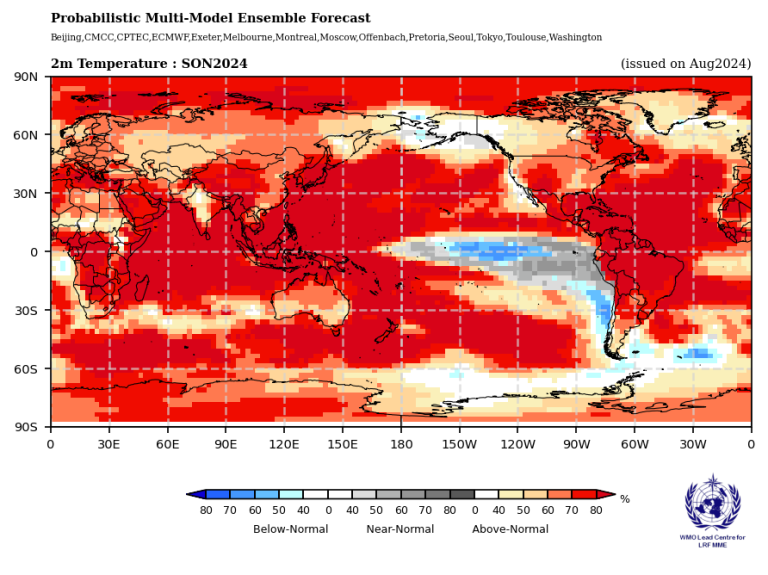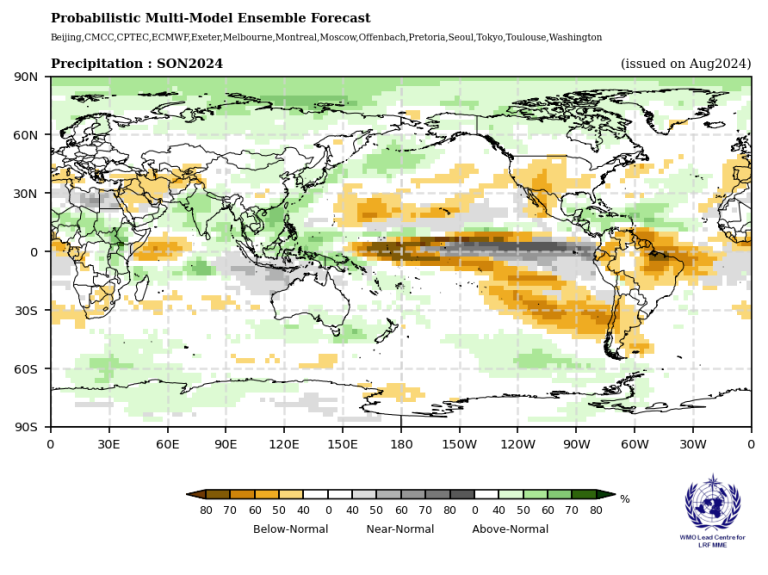WMO Update predicts 60% chance of La Niña
There is a 60% chance of La Niña conditions emerging towards the end of this year, according to a new Update from the World Meteorological Organization (WMO).
- La Niña has relative short-term cooling impact on global climate
- It generally has opposite impacts to El Niño
- Longer-term global warming continues
- “Neutral” El Niño-Southern Oscillation conditions currently prevail
- Early warnings and seasonal predictions help climate adaptation

Latest forecasts from WMO Global Producing Centres of Long-Range Forecasts indicate a 55% likelihood of a transition from the current neutral conditions (neither El Niño nor La Niña) to La Nina conditions during September-November 2024. This likelihood increases to 60% from October 2024 to February 2025, with the chance of El Niño redeveloping during this time being negligible.
La Niña refers to the large-scale cooling of the ocean surface temperatures in the central and eastern equatorial Pacific Ocean, coupled with changes in the tropical atmospheric circulation, such as winds, pressure and rainfall. The effects of each La Niña event vary depending on its intensity, duration, time of year it develops, and the interaction with other climate drivers. Generally, La Niña produces the opposite climate impacts to El Niño, especially in tropical regions.
However, naturally occurring climate events such as La Nina and El Nino events are taking place in the broader context of human-induced climate change, which is increasing global temperatures, exacerbating extreme weather and climate, and impacting seasonal rainfall and temperature patterns.
WMO Secretary-General Celeste Saulo highlights that “Since June 2023 we have seen an extended streak of exceptional global land and sea surface temperature. Even if a short-term cooling La Niña event does emerge, it will not change the long-term trajectory of rising global temperatures due to heat-trapping greenhouse gases in the atmosphere."
The past nine years have been the warmest on record even with the cooling influence of a multi-year La Niña from 2020 to early 2023. The 2023-24 El Niño event started emerging in June 2023 and peaked in November 2023 - January 2024 as one of the five strongest on record before dissipating – although some impacts continued.
“For the past three months, neutral conditions have prevailed – neither El Niño nor La Niña. But we have still seen widespread extreme weather conditions, including intense heat and devastating rainfall. This is why the Early Warnings for All initiative remains WMO’s top priority. Seasonal forecasts for El Niño and La Niña and the associated impacts on the climate patterns globally are an important tool to inform early warnings and early action,” said Celeste Saulo.

Global Seasonal Climate Update
Given that the El Niño Southern Oscillation (ENSO) is not the only driver of the Earth’s climate system, WMO also issues regular Global Seasonal Climate Updates (GSCU). These updates incorporate the influences of other major climate variability modes, including the North Atlantic Oscillation, the Arctic Oscillation and the Indian Ocean Dipole.
The latest GSCU indicates that widespread above-normal sea-surface temperatures are expected to persist in all ocean basins apart from the near-equatorial eastern Pacific Ocean (consistent with the predicted emergence of weak La Niña conditions). As a result, above-normal temperatures are predicted over almost all land areas.
Predictions for large-scale rainfall patterns partially align with the typical impacts observed during the early stage of La Niña conditions, including above-normal rainfall in far northern South America, Central America, the Caribbean, northern Greater Horn of Africa and the Sahel, parts of southeast Asia and central Maritime Continent.
The WMO Updates are based on WMO Global Producing Centres of Long-Range Forecasts and are designed to support governments, the United Nations, decision-makers and stakeholders in climate-sensitive sectors to protect lives and livelihoods.
WMO Regional Climate Centres and National Meteorological and Hydrological Services (NMHSs) will closely monitor changes in the state of ENSO over the coming months.


The World Meteorological Organization (WMO) is a specialized agency of the United Nations responsible for promoting international cooperation in atmospheric science and meteorology.
WMO monitors weather, climate, and water resources and provides support to its Members in forecasting and disaster mitigation. The organization is committed to advancing scientific knowledge and improving public safety and well-being through its work.
For further information, please contact:
- Clare Nullis WMO media officer cnullis@wmo.int +41 79 709 13 97
- WMO Strategic Communication Office Media Contact media@wmo.int

